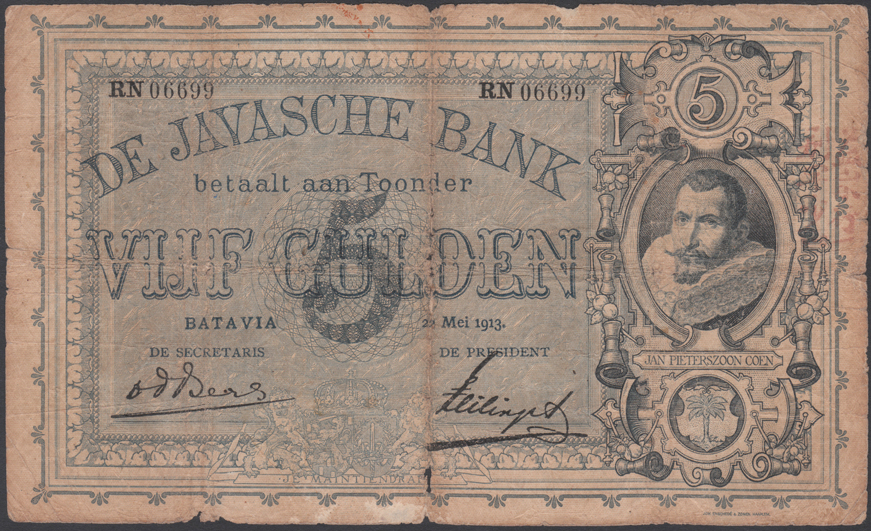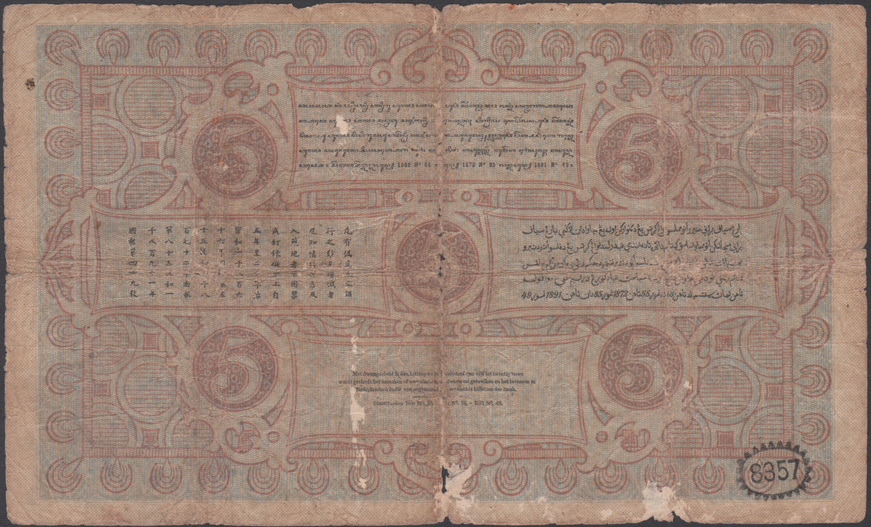February 2009
- By Rob Huisman
All banknotes issued by De Javasche Bank in the Netherlands Indies during the period 1864 till 1931 and printed by Johan Enschede en Zonen, carry a security code, printed on the lower right corner of the reverse. The code is printed black in an elliptical stamp with triangular shapes pointing outwards and has 4 or 5 numbers. Lower denomination state notes issued during this period do not have this security system.
Collectors that are familiair with the Netherlands Indies banknotes of this period will probably have noticed that there is a relation between the date of issue and the security code. Although it looks like the later the date the higher the number, in reality this is not always the case.
5 gulden, May 22, 1913, security code 8357
– One unique security code is always connected to only one specific date
– One specific date occurs with different security codes, however the security codes are close together
– When more notes of the same issue occur with the same date and security code, the notes have the same character combination in the serial number
– When a date occurs with more than one security code, each unique security code occurs with different character combinations in the serial number of a specific issue or the security code is connected to another issued denomination
– Many dates are skipped; there are gaps of many days or weeks between one and the next security code
– Notes with different denominations were issued on the same date with different security codes
– It seems that one sequential number range is used for the security code that covers all the issued notes of the whole period
– There are some exceptions where later dates have lower security code numbers
– There are no different serial number character combinations of a specific denomination with the same security code.
– The change from 4 to 5 numbers happens in the course of 1918
– SPECIMEN notes often have deviating security codes that do not match the usual sequential increase of security code and date 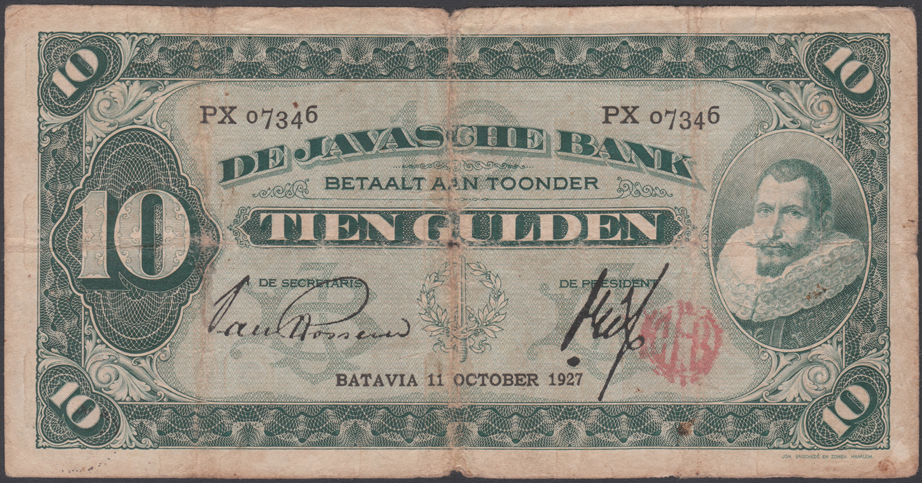
 10 gulden, October 11, 1927, security code 14106
10 gulden, October 11, 1927, security code 14106 

10 gulden, October 11, 1927, security code 14114
The above pictures show two 10 gulden notes from the same date with different security codes. Since security codes were assigned per character combination of the serial number, the explanation is as follows:
PX = 14106
PY = 14107
PZ = 14108
Q = skipped/not used
RA = 14109
RB = 14110
RC = 14111
RD = 14112
RE = 14113
RF = 14114
It is safe to conclude that all ranges PX, PY, PZ, RA, RB, RC, RD, RE and RF were issued on October 11, 1927.
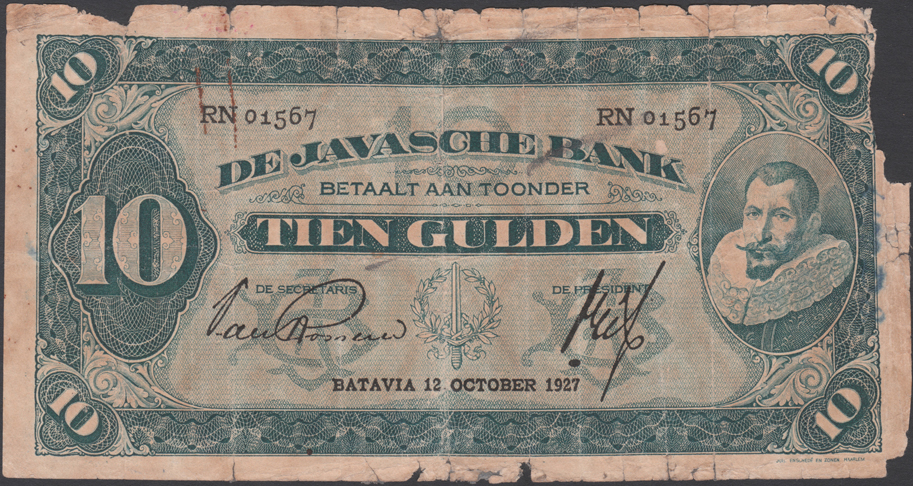
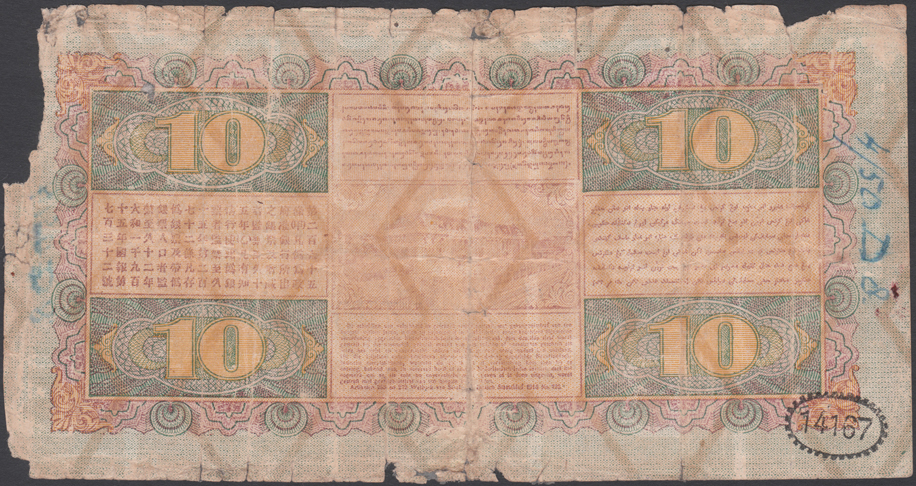 10 gulden Forgery, October 12, 1927, security code 14167
10 gulden Forgery, October 12, 1927, security code 14167
It is unclear if the security code really prevented counterfeiting of these banknotes. The above forgery note shows that counterfeiters were able to print good quality falsifications and used security codes that were close to the real security codes ranges used by De Javasche Bank. The security code system was in use for many years, therefore counterfeiters must have been in the position to figure out the structure during those years.
Another example of the application of the security code:
5 gulden, Serie Coen II, KUKI H-126
security code 15536 – 22 april 1930, serial number GP 03523 (1)
security code 15540 – 22 april 1930, serial number GU 07581 (3)
security code 15563 – 25 april 1930, serial number HS 06270 (3)
security code 15571 – 26 april 1930, serial number IA 03628 (7)
GP = 15536
GQ = skipped/not used
GR = 15537
GS = 15538
GT = 15539
GU = 15540
~
HR = 15562
HS = 15563
HT = 15564
~
HZ = 15570
IA = 15571
In the above case the character combinations of the serial number have a 1-to-1 increase with the security code. This is most often not the case since also other denominations were issued on the same date. In those cases the security code is assigned randomly to the different issues, however the rule that one securrity code is connected to one character combination of one specific issue remains.
Obviously the Dutch administered Bank will have kept detailed records of the security codes and the dates and serial numbers of all the issued banknotes. It is unknown if these records of De Javasche Bank still exist in archives somewhere today.
++++
The author would like to receive feedback; please e-mail via info@uang-kertas.com
================
- Sources:
- 1. Catalogue of CollectPlaza International Auctions BV, May 2005, Leidschendam, The Netherlands
- 2. Catalogue of CollectPlaza International Auctions BV, November 2005, Leidschendam, The Netherlands
- 3. Catalogue of CollectPlaza International Auctions BV, May 2006, Leidschendam, The Netherlands
- 4. Catalogue of CollectPlaza International Auctions BV, December 2006, Leidschendam, The Netherlands
- 5. Catalogue of Corné Akkermans Veilingen BV, Veiling 5, Culemborg, the Netherlands
- 6. Catalogue of Corné Akkermans Auctions, Corné Akkermans Veilingen BV, Auction 6/7, Culemborg, the Netherlands
- 7. Catalogue of Corné Akkermans Auctions, Corné Akkermans Veilingen BV, Auction 8, Culemborg, the Netherlands
- 8. Catalogue of Corné Akkermans Auctions, Corné Akkermans Veilingen BV, Auction 9, Culemborg, the Netherlands
- 9. Catalogue of Corné Akkermans Auctions, Corné Akkermans Veilingen BV, Auction 10, Culemborg, the Netherland
- 10. Banknotes and Coins from Indonesia, 1945-1990, Yayasan Serangan Umum 1 Maret 1949 & Perum Peruri Jakarta (BCI)
- 11. Catalogue of Paper Money of the V.O.C., Netherlands East Indies and Indonesia, from 1782 to 1981, Johan Mevius, Vriezeveen, 1981
- 12. Katalog Uang Kertas Indonesia 1782-2005, PT. Sugijaya Abadi Sentosa, Edisi ke 2 (KUKI)

